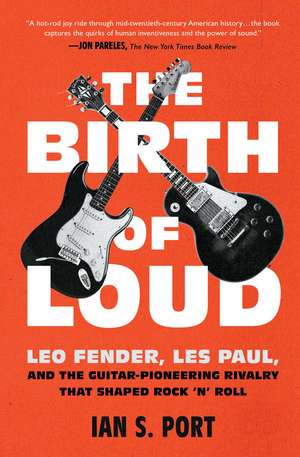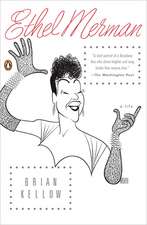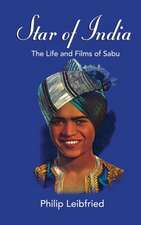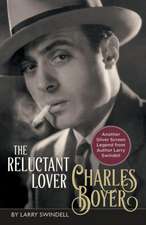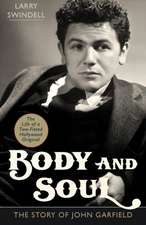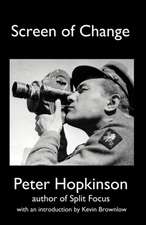The Birth of Loud: Leo Fender, Les Paul, and the Guitar-Pioneering Rivalry That Shaped Rock 'n' Roll
Autor Ian S. Porten Limba Engleză Paperback – 9 ian 2020
In the years after World War II, music was evolving from big-band jazz into rock ’n’ roll—and these louder styles demanded revolutionary instruments. When Leo Fender’s tiny firm marketed the first solid-body electric guitar, the Esquire, musicians immediately saw its appeal. Not to be out-maneuvered, Gibson, the largest guitar manufacturer, raced to build a competitive product. The company designed an “axe” that would make Fender’s Esquire look cheap and convinced Les Paul—whose endorsement Leo Fender had sought—to put his name on it. Thus was born the guitar world’s most heated rivalry: Gibson versus Fender, Les versus Leo.
While Fender was a quiet, half-blind, self-taught radio repairman, Paul was a brilliant but headstrong pop star and guitarist who spent years toying with new musical technologies. Their contest turned into an arms race as the most inventive musicians of the 1950s and 1960s—including bluesman Muddy Waters, rocker Buddy Holly, the Beatles, Bob Dylan, and Eric Clapton—adopted one maker’s guitar or another. By 1969 it was clear that these new electric instruments had launched music into a radical new age, empowering artists with a vibrancy and volume never before attainable.
In “an excellent dual portrait” (The Wall Street Journal), Ian S. Port tells the full story in The Birth of Loud, offering “spot-on human characterizations, and erotic paeans to the bodies of guitars” (The Atlantic). “The story of these instruments is the story of America in the postwar era: loud, cocky, brash, aggressively new” (The Washington Post).
Preț: 66.55 lei
Preț vechi: 82.75 lei
-20% Nou
Puncte Express: 100
Preț estimativ în valută:
12.74€ • 13.84$ • 10.71£
12.74€ • 13.84$ • 10.71£
Carte disponibilă
Livrare economică 04-16 aprilie
Livrare express 15-21 martie pentru 38.62 lei
Preluare comenzi: 021 569.72.76
Specificații
ISBN-13: 9781501141737
ISBN-10: 1501141732
Pagini: 352
Ilustrații: 1-c 8 pg insert
Dimensiuni: 140 x 213 x 18 mm
Greutate: 0.3 kg
Editura: Scribner
Colecția Scribner
ISBN-10: 1501141732
Pagini: 352
Ilustrații: 1-c 8 pg insert
Dimensiuni: 140 x 213 x 18 mm
Greutate: 0.3 kg
Editura: Scribner
Colecția Scribner
Notă biografică
Ian S. Port is an award-winning writer and music critic whose work has appeared in Rolling Stone, Village Voice, The Threepenny Review, and The Believer, among others. He is also the former music editor of the San Francisco Weekly. A lifelong guitar player and California native, he and his wife now live in New York City. The Birth of Loud is his first book.
Extras
The Birth of Loud
![]()
SANTA MONICA, 1964
The screams came in waves, hysterical and elated, punctuated by applause. Then the camera found them: five men in matching striped shirts, teetering with nerves, grinning like children. The Beach Boys. A clap on the snare drum sent the song rumbling to life, and the players at the stage’s front tapped their feet to stay in time. Punches from the drum kit underpinned a sheen of male voices in harmony. But fighting for prominence was another noise—a throaty, splattering sonic current.
Curious instruments hung over the striped shoulders of the men in front. Two of the instruments were painted white, with thin bodies and voluptuous curves that suggested spaceships, or amoebae, or the human torso. Behind their players sat cream-colored cabinets the size of refrigerators, massive speakers barely visible inside, components in a new system of noisemaking. These sleek guitars transformed single notes and chords into flows of electrons, while the amplifiers converted those electrons into wild new tones—tones that came out piercingly human despite their electric hue.
There was no piano, no saxophone or trumpet, no bandleader, no orchestra. Besides their drums and voices, the Beach Boys wielded just these bloblike guitars, each dependent on electricity, each able to produce ear-piercing quantities of sound, and nearly all bearing the name Fender. Their amplified blare seemed to encourage the shrieks of fans buffeting the stage, their bodies swaying to the thrumming joys of “Surfin’ USA.”
When this scene played in American movie theaters just after Christmas 1964, it was a vision of the future. It was part of a filmed rock ’n’ roll concert—the very first—that also showed the Rolling Stones seething and strutting, and James Brown pulling off terpsichorean heroics unlike anything most of the American public had yet seen. The Teenage Awards Music International Show looked like one more entry in a procession of frivolous teen movies, but it arrived with the shock of the new. It was a multiracial assemblage of the day’s most famous pop stars, captured on film alongside bikini-clad go-go dancers and howling youths. Movie critics mostly sniffed. “Adults, unaware of the differences between these numerous young groups, view the combined efforts as fairly monotonous,” went a typical assessment. But a new order was establishing itself.
One of its precepts was racial equality, or at least the sincere pursuit of such. It was a celebration that both targeted and was beholden to the American teenager. And it prized music played on electric instruments that gave individual musicians a vast new sonic palette—and volume level—with which to express themselves.
Only fifteen years earlier, this scene would have been unrecognizable. Popular music had been the domain of dedicated artisans, trained pros in tuxedos who read notes on paper and sat on bandstands in disciplined regiments, led by a big name in a bow tie. Crooners like Bing Crosby acted out songs written for them by others, and sang for adults, not young people. Nearly everyone who joined them on the pop charts had white skin.
But in the boom years after World War II, teenagers had wrested control of the market for pop music, and many lacked their parents’ racial prejudice. Singers like Chuck Berry and Bo Diddley, and later Marvin Gaye and the Supremes, rose onto charts once ruled by whites. These cultural changes were accelerated by a complementary revolution in the technology of music-making. By the night The T.A.M.I. Show was filmed in 1964, anyone with the right equipment could achieve volumes that would reach hundreds or thousands of onlookers. The new rulers of music could manipulate electric guitars and amps to produce a universe of evocative or alien new sounds.
One company had done more than any other to usher in the technology that was changing listeners’ aural experiences. One company had made electric guitars into ubiquitous leisure accessories, by supplying cheap, sturdy instruments to amateurs and professionals alike. This firm was the first in its industry to align itself with the tastes of young people, among the first to paint guitars bright red and later metal-flake blue and purple, first to give its models sexy monikers like the Stratocaster and the Jaguar.
Competitors had long mocked the creations of the Fender Electric Instrument Company, but this Southern California upstart had an asset unlike any other—a self-taught tinkerer whose modesty was utterly at odds with the brash characters who used his tools. Clad in perpetually drab workmen’s clothes, preferring to spend most of his waking hours designing and building in his lab, Clarence Leo Fender toiled endlessly to perfect the tools that ushered in pop music’s electric revolution, yet he couldn’t play a single instrument himself. Instead, he trusted musicians, whom he loved, to tell him what they wanted. In the waning days of World War II, Leo Fender had started building guitars and amplifiers in the back of his radio repair shop. By that night in 1964, the company he’d built dominated the burgeoning market for electric instruments.
At least, for the moment.
Showing off their striped, short-sleeve shirts, the Beach Boys appeared clean-cut and respectable, apparently (if not actually) innocent young men. To close out The T.A.M.I. Show, a quintet of Brits arrived wearing modish dark suits and expressions of bemused insouciance, even outright hostility. The lead singer’s dark hair fell in curls down to his collar as he prowled the stage, thick lips pressed up against the microphone, hunting and taunting his young quarry. To his left, a craggy-faced guitarist beat on an unfamiliar instrument. That small, solid-bodied guitar responded with snarls and growls, a thick, surging sound that couldn’t have been more different from the thin rays of light that had emanated from the Beach Boys’ Fenders.
The earlier act embodied rock ’n’ roll life as a teen idyll, a carefree jaunt in which sex was mentioned only euphemistically, and hardly ever as a source of conflict. Minutes later, the Rolling Stones made rock into a carnal fantasy, a dim mélange of ego and lust, betrayal and satisfaction. Already labeled rock ’n’ roll’s bad boys, the five young Brits embraced the role in performance and offstage, viewing the Beach Boys—another band of white men using electric guitars to play music first created by black men—as entrants in a completely different competition.
The Rolling Stones did sound new and distinct. And part of what then fueled the difference was an instrument discovered in a secondhand music shop in London, a secret weapon for producing the nasty tones this outfit preferred. It was a guitar, made by the venerable Gibson company, that bore the name Les Paul. Thanks to Keith Richards and certain other British rockers, this Les Paul guitar would soon rise again to become Fender instruments’ prime companion and rival—just as the man it was named after had been many years earlier.
For Les Paul himself was as emphatic and as colorful as human beings come, as loud and public as Leo Fender was quiet and private: a brilliant player and a gifted technician, a charmer and a comedian, a raconteur and a tireless worker who hungered for the top of the pop charts. Out of his roots in country and jazz, Les Paul had invented a flashy style of playing that was immediately recognizable as his own, a style that would help define the instrument for generations of ambitious guitarists. But almost since the moment he began playing, Les Paul had found existing guitars inadequate. He knew what he wanted and what he thought would make him a star: a loud, sustaining, purely electric guitar sound. Nothing would give it to him.
His search for this pure tone—and through it, fame—led him to California, to a wary friendship with the self-taught tinkerer Leo Fender, who was interested in the same problem. The two men began experimenting together, pioneering the future of music. But when Les finally managed to drag the guitar out from its supporting role and deposit it at the center of American culture—and when a radical new electric guitar design finally became reality—their friendship fractured into rivalry. The greatest competitor to Leo Fender’s instruments was soon a Gibson model with Les Paul’s signature emblazoned in gold. From then on, it was Fender vs. Gibson, Leo Fender vs. Les Paul, their namesake electric guitars battling for the affections of a vast generation of players inspired by the new sound of rock ’n’ roll.
For a brief period this competition seemed to abate. But soon after Keith Richards appeared in The T.A.M.I. Show using his Gibson Les Paul, his peers in the British rock scene would find that this instrument could produce tones then out of reach of any other guitar—including a Fender. The Gibson Les Paul could become molten, searing, heavy: sounds for which it was never intended, but which were now wildly desirable. This guitar’s look and sound would go on to virtually define a new style of blues-based hard rock.
So almost from the moment the Beach Boys and the Rolling Stones shared a stage in The T.A.M.I. Show, the old Fender-Gibson rivalry, that competition between the unassuming Leo Fender and the attention-seeking Les Paul, reignited. Once begun, this showdown—between bright and dark, thin and thick, light and heavy, West and East, new and old—would consume countless future musicians, as it still does to this day.
But both men’s instruments would also further a larger struggle. Whether in the hands of Chuck Berry or Buddy Holly, Jimi Hendrix or the Velvet Underground, Sly and the Family Stone or Led Zeppelin, Prince or the Runaways, Bad Brains or Sleater-Kinney, electric guitars would be used to make music with a tolerance—stated, if imperfectly applied—for people of different racial and ethnic identities. The music fueled by these instruments sought a single audience, or at least one ever-expanding group of listeners, who thought of themselves, however improbably, as young. And perhaps this bias toward diversity and youth explains some of the hostile words so casually published in 1964.
For there were proper adults in the audience of the Santa Monica Civic Auditorium on the night The T.A.M.I. Show was filmed. There were grown-ups sitting in the many movie theaters where it played. Were they really so bored by James Brown and the Rolling Stones, Marvin Gaye and the Beach Boys? Or did they perhaps sense that young people, armed with Leo Fender’s and Les Paul’s powerful new tools, might finally finish the cultural revolution they’d long been threatening?
PROLOGUE
SANTA MONICA, 1964
The screams came in waves, hysterical and elated, punctuated by applause. Then the camera found them: five men in matching striped shirts, teetering with nerves, grinning like children. The Beach Boys. A clap on the snare drum sent the song rumbling to life, and the players at the stage’s front tapped their feet to stay in time. Punches from the drum kit underpinned a sheen of male voices in harmony. But fighting for prominence was another noise—a throaty, splattering sonic current.
Curious instruments hung over the striped shoulders of the men in front. Two of the instruments were painted white, with thin bodies and voluptuous curves that suggested spaceships, or amoebae, or the human torso. Behind their players sat cream-colored cabinets the size of refrigerators, massive speakers barely visible inside, components in a new system of noisemaking. These sleek guitars transformed single notes and chords into flows of electrons, while the amplifiers converted those electrons into wild new tones—tones that came out piercingly human despite their electric hue.
There was no piano, no saxophone or trumpet, no bandleader, no orchestra. Besides their drums and voices, the Beach Boys wielded just these bloblike guitars, each dependent on electricity, each able to produce ear-piercing quantities of sound, and nearly all bearing the name Fender. Their amplified blare seemed to encourage the shrieks of fans buffeting the stage, their bodies swaying to the thrumming joys of “Surfin’ USA.”
When this scene played in American movie theaters just after Christmas 1964, it was a vision of the future. It was part of a filmed rock ’n’ roll concert—the very first—that also showed the Rolling Stones seething and strutting, and James Brown pulling off terpsichorean heroics unlike anything most of the American public had yet seen. The Teenage Awards Music International Show looked like one more entry in a procession of frivolous teen movies, but it arrived with the shock of the new. It was a multiracial assemblage of the day’s most famous pop stars, captured on film alongside bikini-clad go-go dancers and howling youths. Movie critics mostly sniffed. “Adults, unaware of the differences between these numerous young groups, view the combined efforts as fairly monotonous,” went a typical assessment. But a new order was establishing itself.
One of its precepts was racial equality, or at least the sincere pursuit of such. It was a celebration that both targeted and was beholden to the American teenager. And it prized music played on electric instruments that gave individual musicians a vast new sonic palette—and volume level—with which to express themselves.
Only fifteen years earlier, this scene would have been unrecognizable. Popular music had been the domain of dedicated artisans, trained pros in tuxedos who read notes on paper and sat on bandstands in disciplined regiments, led by a big name in a bow tie. Crooners like Bing Crosby acted out songs written for them by others, and sang for adults, not young people. Nearly everyone who joined them on the pop charts had white skin.
But in the boom years after World War II, teenagers had wrested control of the market for pop music, and many lacked their parents’ racial prejudice. Singers like Chuck Berry and Bo Diddley, and later Marvin Gaye and the Supremes, rose onto charts once ruled by whites. These cultural changes were accelerated by a complementary revolution in the technology of music-making. By the night The T.A.M.I. Show was filmed in 1964, anyone with the right equipment could achieve volumes that would reach hundreds or thousands of onlookers. The new rulers of music could manipulate electric guitars and amps to produce a universe of evocative or alien new sounds.
One company had done more than any other to usher in the technology that was changing listeners’ aural experiences. One company had made electric guitars into ubiquitous leisure accessories, by supplying cheap, sturdy instruments to amateurs and professionals alike. This firm was the first in its industry to align itself with the tastes of young people, among the first to paint guitars bright red and later metal-flake blue and purple, first to give its models sexy monikers like the Stratocaster and the Jaguar.
Competitors had long mocked the creations of the Fender Electric Instrument Company, but this Southern California upstart had an asset unlike any other—a self-taught tinkerer whose modesty was utterly at odds with the brash characters who used his tools. Clad in perpetually drab workmen’s clothes, preferring to spend most of his waking hours designing and building in his lab, Clarence Leo Fender toiled endlessly to perfect the tools that ushered in pop music’s electric revolution, yet he couldn’t play a single instrument himself. Instead, he trusted musicians, whom he loved, to tell him what they wanted. In the waning days of World War II, Leo Fender had started building guitars and amplifiers in the back of his radio repair shop. By that night in 1964, the company he’d built dominated the burgeoning market for electric instruments.
At least, for the moment.
Showing off their striped, short-sleeve shirts, the Beach Boys appeared clean-cut and respectable, apparently (if not actually) innocent young men. To close out The T.A.M.I. Show, a quintet of Brits arrived wearing modish dark suits and expressions of bemused insouciance, even outright hostility. The lead singer’s dark hair fell in curls down to his collar as he prowled the stage, thick lips pressed up against the microphone, hunting and taunting his young quarry. To his left, a craggy-faced guitarist beat on an unfamiliar instrument. That small, solid-bodied guitar responded with snarls and growls, a thick, surging sound that couldn’t have been more different from the thin rays of light that had emanated from the Beach Boys’ Fenders.
The earlier act embodied rock ’n’ roll life as a teen idyll, a carefree jaunt in which sex was mentioned only euphemistically, and hardly ever as a source of conflict. Minutes later, the Rolling Stones made rock into a carnal fantasy, a dim mélange of ego and lust, betrayal and satisfaction. Already labeled rock ’n’ roll’s bad boys, the five young Brits embraced the role in performance and offstage, viewing the Beach Boys—another band of white men using electric guitars to play music first created by black men—as entrants in a completely different competition.
The Rolling Stones did sound new and distinct. And part of what then fueled the difference was an instrument discovered in a secondhand music shop in London, a secret weapon for producing the nasty tones this outfit preferred. It was a guitar, made by the venerable Gibson company, that bore the name Les Paul. Thanks to Keith Richards and certain other British rockers, this Les Paul guitar would soon rise again to become Fender instruments’ prime companion and rival—just as the man it was named after had been many years earlier.
For Les Paul himself was as emphatic and as colorful as human beings come, as loud and public as Leo Fender was quiet and private: a brilliant player and a gifted technician, a charmer and a comedian, a raconteur and a tireless worker who hungered for the top of the pop charts. Out of his roots in country and jazz, Les Paul had invented a flashy style of playing that was immediately recognizable as his own, a style that would help define the instrument for generations of ambitious guitarists. But almost since the moment he began playing, Les Paul had found existing guitars inadequate. He knew what he wanted and what he thought would make him a star: a loud, sustaining, purely electric guitar sound. Nothing would give it to him.
His search for this pure tone—and through it, fame—led him to California, to a wary friendship with the self-taught tinkerer Leo Fender, who was interested in the same problem. The two men began experimenting together, pioneering the future of music. But when Les finally managed to drag the guitar out from its supporting role and deposit it at the center of American culture—and when a radical new electric guitar design finally became reality—their friendship fractured into rivalry. The greatest competitor to Leo Fender’s instruments was soon a Gibson model with Les Paul’s signature emblazoned in gold. From then on, it was Fender vs. Gibson, Leo Fender vs. Les Paul, their namesake electric guitars battling for the affections of a vast generation of players inspired by the new sound of rock ’n’ roll.
For a brief period this competition seemed to abate. But soon after Keith Richards appeared in The T.A.M.I. Show using his Gibson Les Paul, his peers in the British rock scene would find that this instrument could produce tones then out of reach of any other guitar—including a Fender. The Gibson Les Paul could become molten, searing, heavy: sounds for which it was never intended, but which were now wildly desirable. This guitar’s look and sound would go on to virtually define a new style of blues-based hard rock.
So almost from the moment the Beach Boys and the Rolling Stones shared a stage in The T.A.M.I. Show, the old Fender-Gibson rivalry, that competition between the unassuming Leo Fender and the attention-seeking Les Paul, reignited. Once begun, this showdown—between bright and dark, thin and thick, light and heavy, West and East, new and old—would consume countless future musicians, as it still does to this day.
But both men’s instruments would also further a larger struggle. Whether in the hands of Chuck Berry or Buddy Holly, Jimi Hendrix or the Velvet Underground, Sly and the Family Stone or Led Zeppelin, Prince or the Runaways, Bad Brains or Sleater-Kinney, electric guitars would be used to make music with a tolerance—stated, if imperfectly applied—for people of different racial and ethnic identities. The music fueled by these instruments sought a single audience, or at least one ever-expanding group of listeners, who thought of themselves, however improbably, as young. And perhaps this bias toward diversity and youth explains some of the hostile words so casually published in 1964.
For there were proper adults in the audience of the Santa Monica Civic Auditorium on the night The T.A.M.I. Show was filmed. There were grown-ups sitting in the many movie theaters where it played. Were they really so bored by James Brown and the Rolling Stones, Marvin Gaye and the Beach Boys? Or did they perhaps sense that young people, armed with Leo Fender’s and Les Paul’s powerful new tools, might finally finish the cultural revolution they’d long been threatening?
Recenzii
New York Times Book Review Editors' Choice
“In The Birth of Loud, Ian S. Port has sorted out the facts of the electric guitar’s much-mythologized genesis and cultural conquest. He turns them into a hot-rod joy ride through mid-20th-century American history. With appropriately flashy prose, he dismantles some misconceptions and credits some nearly forgotten but key figures. He also summons, exuberantly and perceptively, the look, sound, and sometimes smell of pivotal scenes and songs. The Birth of Loud rightfully celebrates an earlier time, when wood, steel, copper wire, microphones and loudspeakers could redefine reality. Tracing material choices that echoed through generations, the book captures the quirks of human inventiveness and the power of sound.”
—Jon Pareles, New York Times Book Review
“Fascinating . . . one of Port’s true strengths [is] his ability to marry an agreeably anecdotal writing style to a musician’s ear. The way a Telecaster snaps and sizzles, the way a Les Paul purrs with liquid, violin-like tones; he just gets it. . . The story of these instruments is the story of America in the postwar era: loud, cocky, brash, aggressively new.”
—Washington Post
“[An] excellent dual portrait . . . In the second half of the book, Mr. Port, a veteran music journalist, touches on the work of every major guitar player of rock’s golden age, from Muddy Waters to Buddy Holly—whose appearance on “The Ed Sullivan Show” electrified (the pun is unavoidable) Eric Clapton and Paul McCartney and John Lennon—and continuing through Jimi Hendrix, Jimmy Page and, of course, Bob Dylan, whose notorious switch from acoustic to electric at the 1965 Newport Folk Festival scandalized his fans. Not everyone played a Fender or a Les Paul—the Beatles were Rickenbacker fans, and Gretsch guitars had a significant market share—but, as Mr. Port says, the wildfire popularity of those two guitars fueled a world-changing demand for electric guitars of every type.”
—Wall Street Journal
“Rich in description . . . full of imagist sound-summonings, spot-on human characterizations, and erotic paeans to the bodies of guitars . . . Port can write lovingly, such as when he describes an early, solid-wood model that belonged to the country twanger Merle Travis. . . And he can write with technical lyricism . . . He even made me like Eric Clapton for a minute. And from the fumbled genesis of the electric guitar to its expressive climax, he draws us a beautiful, educational arc.”
—The Atlantic
“Ian S. Port’s The Birth of Loud reframes the standard history of rock ’n’ roll around the dual creators of the modern electric guitar. . . . Instead of a parade of frontmen and songwriters dueling it out in the charts, Port presents a ground-up account of an at-times begrudging friendship between two Angelenos who created the sound of what we instinctively understand as ‘rock.’ . . . Port’s research is thorough and his prose is lucid. If the evanescence of the internet and the machine-like qualities of synthpop make you want to put words to that vague cultural hunger for something more tactile, more connected to physical reality, this is your book. . . . The Birth of Loud is a compelling addition to the misremembered history of the time.”
—SF Weekly
“[Tells] the story of the development of the electric guitar through the lives of its two most famous names….Port deftly toggles between their parallel paths, as if swiveling from one effects pedal to another.”
—James Sullivan, San Francisco Chronicle
“Ian S. Port knows a thing or two about guitar heroes. . . . [With] lyrical, evocative prose, The Birth of Loud includes vivid scenes of Muddy Waters inventing Chicago blues, the Rolling Stones' sex-drenched appearance on The T.A.M.I. Show, Buddy Holly's TV debut with Ed Sullivan, Bob Dylan going electric at Newport and more. Along the way, Fender and Paul hone their inventions to perfection, vie for endorsements from the hottest players, and engage in that age-old driver of American innovation: cutthroat competition.”
—KQED “Arts”
“A rip-roaring journey through the early days of rock 'n' roll, told through the lives of the men whose innovative guitars helped usher it into existence . . . A lively, difficult-to-put-down portrait of an important era of American art that enhances readers' appreciation for the music it depicts.”
—Kirkus Reviews (Starred Review)
“A page-turning look at two central players [Leo Fender and Les Paul] in the sonic evolution of popular music. Port explores their trials and tribulations with an expert hand. This is a long-overdue cultural biography of music innovation. VERDICT: Thoroughly entertaining and deeply informative, this love letter to American creativity and rock and roll belongs in every library and should be read by all rock fans.”
—Library Journal (Starred Review)
“This smartly written and genuinely exciting book walks us through the bitter rivalry between Fender and Gibson and, since there is no way to tell this story without telling the story of rock ’n’ roll itself, also provides a jaunty if necessarily abbreviated history of rock. For music buffs, this one is special."
—Booklist
“[The] definitive history of the electric guitar and its two foundational personalities [Leo Fender and Les Paul]. Theirs is a fascinating and compelling story, especially in the hands of a writer as committed to lively narrative . . . Port can spin out evocative, succinct rock ’n’ roll writing with the best of them.”
—The New York Journal of Books
“Lushly descriptive and detailed…[the book] is richly illustrative in bringing these rock giants and the tools of their trade to life in a squall of beautiful feedback.”
—Publishers Weekly
“More than an essential, colorful, and gripping history of the electric guitar, The Birth of Loud introduces Ian Port, the best new non-fiction writer of the past twenty years.”
—Daniel J. Levitin, author of This Is Your Brain on Music
“Ian Port’s found a way to tell the story of the birth of rock ‘n’ roll—for some of us, among the postwar American stories, those that help define who we feel ourselves to be—in beautifully-evoked dual portraits of the men who made the instruments. In doing so, he re-situates this story in its context so neatly it is as if it had never been told before at all.”
—Jonathan Lethem, author of Motherless Brooklyn and The Fortress of Solitude
"Ian Port has created a perfect blend of popular history, social commentary, and enough guitar details to satisfy the most rabid six-string geek. This is a fascinating book."
—Jonathan Kellerman, bestselling novelist and author of With Strings Attached: The Art and Beauty of Vintage Guitars
"Guitar players are partly born, partly made, and every one has a story. So, too, are guitars, including the electric guitars that changed the world more than half a century ago. This is their story, and the story of their makers, well-told."
—Gary Marcus, author of Guitar Zero
“Long before Les Paul and Leo Fender were brand names who revolutionized music and changed culture, they were two guys—obsessively tinkering to recreate sounds in their heads. In The Birth of Loud Ian S. Port vividly captures the compulsion and competition that drove these fascinating oddballs to rock the world.”
—Alan Light, former editor-in-chief of Vibe and Spin and author of The Holy or the Broken: Leonard Cohen, Jeff Buckley and the Unlikely Ascent of “Hallelujah”
“It’s hard for me to think of an invention more crucial to my interior life than the electric guitar, so in a way The Birth of Loud, Ian Port’s moving, riveting account of the instrument’s development and rise to ubiquity, feels like a sacred text—the story of how I came to be. It’s also a rich and fascinating tale of obsession, ingenuity, and American abandon. Thank heavens for Les Paul, thank heavens for Leo Fender, and thank heavens for Ian Port.”
—Amanda Petrusich, author Do Not Sell at Any Price: The Wild, Obsessive Hunt for the World's Rarest 78rpm Records
“The Birth of Loud is more than history, journalism or criticism—it’s a killer rock ’n’ roll story, complete with money, egos, star power and, yes, electric guitars.”
—Steve Knopper, author of MJ: The Genius of Michael Jackson and Appetite for Self-Destruction: The Spectacular Crash of the Record Industry in the Digital Age
“The Birth of Loud channels trickles of intriguing new information into a confluence of big ideas about the history of the electric guitar. This book is essential reading for guitar history maniacs!”
—Deke Dickerson, guitar historian, bandleader, and author of The Strat in the Attic
“In The Birth of Loud, Ian S. Port has sorted out the facts of the electric guitar’s much-mythologized genesis and cultural conquest. He turns them into a hot-rod joy ride through mid-20th-century American history. With appropriately flashy prose, he dismantles some misconceptions and credits some nearly forgotten but key figures. He also summons, exuberantly and perceptively, the look, sound, and sometimes smell of pivotal scenes and songs. The Birth of Loud rightfully celebrates an earlier time, when wood, steel, copper wire, microphones and loudspeakers could redefine reality. Tracing material choices that echoed through generations, the book captures the quirks of human inventiveness and the power of sound.”
—Jon Pareles, New York Times Book Review
“Fascinating . . . one of Port’s true strengths [is] his ability to marry an agreeably anecdotal writing style to a musician’s ear. The way a Telecaster snaps and sizzles, the way a Les Paul purrs with liquid, violin-like tones; he just gets it. . . The story of these instruments is the story of America in the postwar era: loud, cocky, brash, aggressively new.”
—Washington Post
“[An] excellent dual portrait . . . In the second half of the book, Mr. Port, a veteran music journalist, touches on the work of every major guitar player of rock’s golden age, from Muddy Waters to Buddy Holly—whose appearance on “The Ed Sullivan Show” electrified (the pun is unavoidable) Eric Clapton and Paul McCartney and John Lennon—and continuing through Jimi Hendrix, Jimmy Page and, of course, Bob Dylan, whose notorious switch from acoustic to electric at the 1965 Newport Folk Festival scandalized his fans. Not everyone played a Fender or a Les Paul—the Beatles were Rickenbacker fans, and Gretsch guitars had a significant market share—but, as Mr. Port says, the wildfire popularity of those two guitars fueled a world-changing demand for electric guitars of every type.”
—Wall Street Journal
“Rich in description . . . full of imagist sound-summonings, spot-on human characterizations, and erotic paeans to the bodies of guitars . . . Port can write lovingly, such as when he describes an early, solid-wood model that belonged to the country twanger Merle Travis. . . And he can write with technical lyricism . . . He even made me like Eric Clapton for a minute. And from the fumbled genesis of the electric guitar to its expressive climax, he draws us a beautiful, educational arc.”
—The Atlantic
“Ian S. Port’s The Birth of Loud reframes the standard history of rock ’n’ roll around the dual creators of the modern electric guitar. . . . Instead of a parade of frontmen and songwriters dueling it out in the charts, Port presents a ground-up account of an at-times begrudging friendship between two Angelenos who created the sound of what we instinctively understand as ‘rock.’ . . . Port’s research is thorough and his prose is lucid. If the evanescence of the internet and the machine-like qualities of synthpop make you want to put words to that vague cultural hunger for something more tactile, more connected to physical reality, this is your book. . . . The Birth of Loud is a compelling addition to the misremembered history of the time.”
—SF Weekly
“[Tells] the story of the development of the electric guitar through the lives of its two most famous names….Port deftly toggles between their parallel paths, as if swiveling from one effects pedal to another.”
—James Sullivan, San Francisco Chronicle
“Ian S. Port knows a thing or two about guitar heroes. . . . [With] lyrical, evocative prose, The Birth of Loud includes vivid scenes of Muddy Waters inventing Chicago blues, the Rolling Stones' sex-drenched appearance on The T.A.M.I. Show, Buddy Holly's TV debut with Ed Sullivan, Bob Dylan going electric at Newport and more. Along the way, Fender and Paul hone their inventions to perfection, vie for endorsements from the hottest players, and engage in that age-old driver of American innovation: cutthroat competition.”
—KQED “Arts”
“A rip-roaring journey through the early days of rock 'n' roll, told through the lives of the men whose innovative guitars helped usher it into existence . . . A lively, difficult-to-put-down portrait of an important era of American art that enhances readers' appreciation for the music it depicts.”
—Kirkus Reviews (Starred Review)
“A page-turning look at two central players [Leo Fender and Les Paul] in the sonic evolution of popular music. Port explores their trials and tribulations with an expert hand. This is a long-overdue cultural biography of music innovation. VERDICT: Thoroughly entertaining and deeply informative, this love letter to American creativity and rock and roll belongs in every library and should be read by all rock fans.”
—Library Journal (Starred Review)
“This smartly written and genuinely exciting book walks us through the bitter rivalry between Fender and Gibson and, since there is no way to tell this story without telling the story of rock ’n’ roll itself, also provides a jaunty if necessarily abbreviated history of rock. For music buffs, this one is special."
—Booklist
“[The] definitive history of the electric guitar and its two foundational personalities [Leo Fender and Les Paul]. Theirs is a fascinating and compelling story, especially in the hands of a writer as committed to lively narrative . . . Port can spin out evocative, succinct rock ’n’ roll writing with the best of them.”
—The New York Journal of Books
“Lushly descriptive and detailed…[the book] is richly illustrative in bringing these rock giants and the tools of their trade to life in a squall of beautiful feedback.”
—Publishers Weekly
“More than an essential, colorful, and gripping history of the electric guitar, The Birth of Loud introduces Ian Port, the best new non-fiction writer of the past twenty years.”
—Daniel J. Levitin, author of This Is Your Brain on Music
“Ian Port’s found a way to tell the story of the birth of rock ‘n’ roll—for some of us, among the postwar American stories, those that help define who we feel ourselves to be—in beautifully-evoked dual portraits of the men who made the instruments. In doing so, he re-situates this story in its context so neatly it is as if it had never been told before at all.”
—Jonathan Lethem, author of Motherless Brooklyn and The Fortress of Solitude
"Ian Port has created a perfect blend of popular history, social commentary, and enough guitar details to satisfy the most rabid six-string geek. This is a fascinating book."
—Jonathan Kellerman, bestselling novelist and author of With Strings Attached: The Art and Beauty of Vintage Guitars
"Guitar players are partly born, partly made, and every one has a story. So, too, are guitars, including the electric guitars that changed the world more than half a century ago. This is their story, and the story of their makers, well-told."
—Gary Marcus, author of Guitar Zero
“Long before Les Paul and Leo Fender were brand names who revolutionized music and changed culture, they were two guys—obsessively tinkering to recreate sounds in their heads. In The Birth of Loud Ian S. Port vividly captures the compulsion and competition that drove these fascinating oddballs to rock the world.”
—Alan Light, former editor-in-chief of Vibe and Spin and author of The Holy or the Broken: Leonard Cohen, Jeff Buckley and the Unlikely Ascent of “Hallelujah”
“It’s hard for me to think of an invention more crucial to my interior life than the electric guitar, so in a way The Birth of Loud, Ian Port’s moving, riveting account of the instrument’s development and rise to ubiquity, feels like a sacred text—the story of how I came to be. It’s also a rich and fascinating tale of obsession, ingenuity, and American abandon. Thank heavens for Les Paul, thank heavens for Leo Fender, and thank heavens for Ian Port.”
—Amanda Petrusich, author Do Not Sell at Any Price: The Wild, Obsessive Hunt for the World's Rarest 78rpm Records
“The Birth of Loud is more than history, journalism or criticism—it’s a killer rock ’n’ roll story, complete with money, egos, star power and, yes, electric guitars.”
—Steve Knopper, author of MJ: The Genius of Michael Jackson and Appetite for Self-Destruction: The Spectacular Crash of the Record Industry in the Digital Age
“The Birth of Loud channels trickles of intriguing new information into a confluence of big ideas about the history of the electric guitar. This book is essential reading for guitar history maniacs!”
—Deke Dickerson, guitar historian, bandleader, and author of The Strat in the Attic
